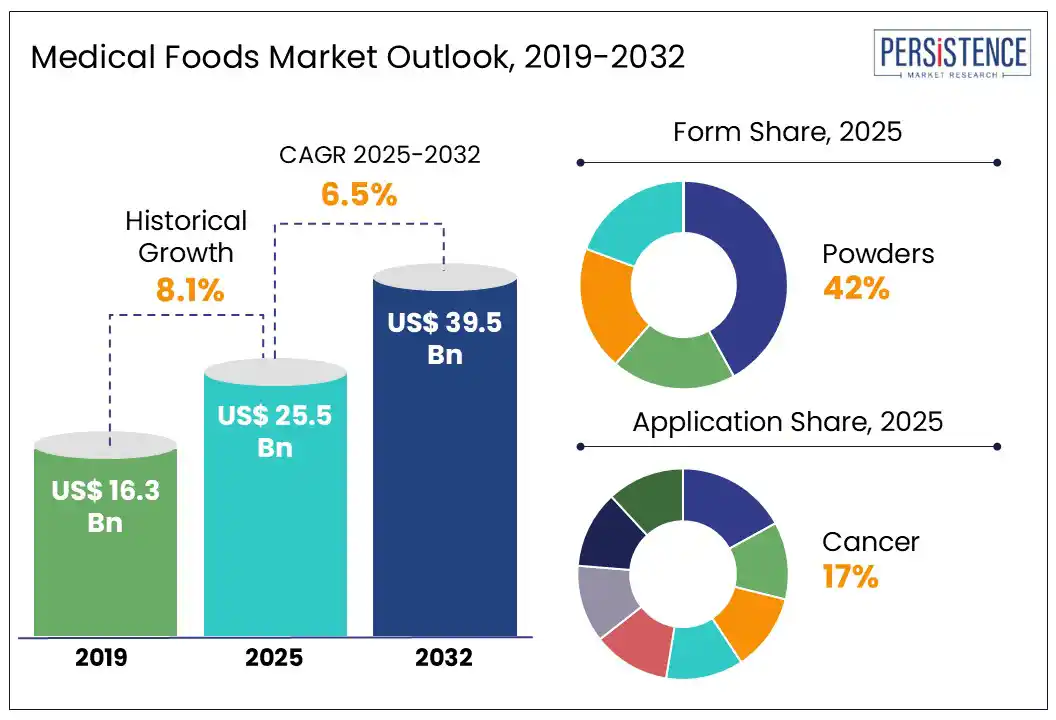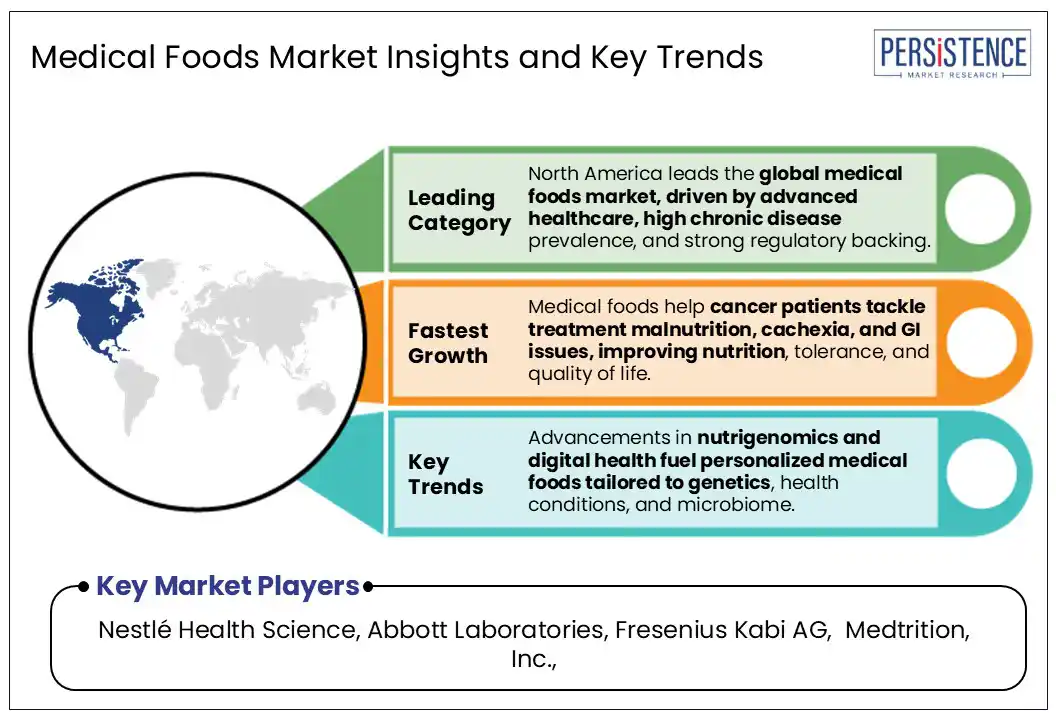ID: PMRREP26854| 195 Pages | 7 Jul 2025 | Format: PDF, Excel, PPT* | Healthcare

The global medical foods market is likely to a CAGR of 6.5% from 2025 to 2032. It is anticipated to increase from US$25.5 Bn in 2025 to a staggering US$39.5 Bn by 2032.
The medical food market is evolving rapidly, driven by the rising prevalence of chronic conditions like Alzheimer’s, cancer, and diabetes. These specialized nutritional products, formulated under medical supervision, are gaining traction for their role in disease-specific dietary management. Increasing healthcare awareness, an aging population, and shifting preference toward personalized nutrition further propel growth. Innovations in delivery formats such as powders, ready-to-drink solutions, and capsules enhance compliance and accessibility. Additionally, regulatory support and investment in clinical nutrition R&D are expanding therapeutic applications. As patient-centric care becomes a healthcare priority, the medical food market is poised for strong, innovation-led global expansion.

Key Industry Highlights:
|
Global Market Attribute |
Key Insights |
|
Medical Foods Market Size (2025E) |
US$ 25.5 Bn |
|
Market Value Forecast (2032F) |
US$ 39.5 Bn |
|
Projected Growth (CAGR 2025 to 2032) |
6.5% |
|
Historical Market Growth (CAGR 2019 to 2024) |
8.1% |
The rising global burden of chronic diseases such as diabetes, cancer, cardiovascular disorders, and Alzheimer’s is significantly fueling the demand for medical foods. Unlike general dietary supplements, medical foods offer condition-specific formulations backed by clinical evidence to address nutritional deficiencies linked to disease pathology. As these chronic illnesses often compromise nutrient absorption, metabolism, or dietary intake, targeted nutritional support becomes essential for disease management and quality of life.
According to the NIHCM Foundation, in the United States alone, chronic diseases are the leading cause of illness, disability, and death, with approximately 6 in 10 Americans living with at least one chronic condition. This results in immense health and economic burdens. Consequently, medical foods are emerging as critical adjuncts to pharmacological therapy, enhancing outcomes and reducing long-term healthcare costs.
Low physician adoption remains a significant barrier in the global medical food market due to a combination of limited education, unclear clinical guidelines, and lack of exposure. Many physicians receive minimal training on nutrition-based therapeutics during their medical education, resulting in skepticism toward medical foods as a credible treatment modality. Additionally, the absence of standardized clinical protocols and the perception that these products overlap with supplements or OTC nutrition often leads doctors to overlook them in treatment planning. In busy clinical settings, physicians also prioritize pharmaceutical interventions with strong evidence and reimbursement support. Without robust awareness programs, peer-reviewed clinical data, and integration into treatment algorithms, medical foods struggle to gain traction among prescribers, ultimately stunting their market penetration and therapeutic impact.
The convergence of nutrigenomics and clinical nutrition is opening transformative opportunities in the medical food space, particularly for rare genetic metabolic disorders such as Phenylketonuria (PKU), Maple Syrup Urine Disease (MSUD), and Homocystinuria. Unlike standard therapeutic diets, personalized medical foods leverage genetic profiling and biomarker data to create precision formulations that match an individual's unique metabolic pathways and nutrient absorption needs. This approach not only enhances patient compliance by optimizing palatability and digestibility but supports better long-term outcomes through targeted metabolic management. With growing access to genetic screening and digital nutrition platforms, companies can now scale customized therapies, offering hope to patients with ultra-rare conditions traditionally underserved by mainstream pharmaceuticals or dietary solutions.
The powder segment accounts for the largest share in the medical foods market due to its versatility, longer shelf life, and ease of formulation customization. Powders allow precise dosing and are ideal for patients with swallowing difficulties or feeding tube requirements. They can be easily reconstituted into liquids or blended into meals, making them suitable across age groups and disease states. Additionally, powders are cost-effective to manufacture, transport, and store, which benefits both manufacturers and healthcare providers. Their compatibility with protein- and amino acid-based formulations also makes them a preferred choice for metabolic, neurological, and gastrointestinal conditions requiring strict dietary control.
The cancer segment holds the largest share in the medical foods market due to the high nutritional demands and metabolic complications faced by oncology patients. Cancer-related cachexia, treatment-induced appetite loss, and compromised nutrient absorption significantly impact patient strength, immunity, and recovery. Medical foods offer targeted nutritional support that helps maintain body weight, enhance energy levels, and improve therapy tolerance. With rising global cancer prevalence and longer treatment durations, the demand for specialized, condition-specific nutritional interventions have surged. Additionally, clinicians recommend medical foods as adjunctive therapy, especially in gastrointestinal, head, and neck cancers, where traditional diets often fail to meet patients’ critical nutritional requirements.
Drug stores & pharmacies dominate the sales channel segment in the medical foods market due to their direct alignment with clinical care pathways and prescription-based nutrition management. As medical foods often target chronic conditions such as cancer, metabolic disorders, and neurological diseases, patients typically access them through healthcare providers who route prescriptions to pharmacies. Pharmacies offer trusted, pharmacist-guided support, ensuring correct product usage and dosage compliance. Their integration with hospital systems, insurance reimbursements, and chronic care programs further strengthens their role. Additionally, the ability to stock condition-specific, high-value products in a regulated environment positions drug stores as the preferred and most reliable distribution point.

The North American medical foods market, particularly in the U.S., is experiencing robust growth driven by the rising prevalence of chronic conditions such as Alzheimer's disease, diabetes, and cancer. Increasing physician awareness and prescription of condition-specific nutritional therapy is accelerating adoption. Regulatory clarity from the U.S. FDA under the Orphan Drug Act and medical food guidelines supports innovation. The U.S. market is also benefiting from the aging population, demand for enteral nutrition in long-term care facilities, and growing recognition of gut-brain axis interventions. Additionally, strong hospital networks and specialized pharmacies ensure wide accessibility, while rising investments in clinical trials and personalized nutrition further solidify North America as a global leader in medical foods.
The European medical foods market is advancing steadily, supported by a well-established clinical nutrition infrastructure and stringent EU regulations that emphasize safety, efficacy, and labeling accuracy. Countries such as Germany, France, and the Netherlands lead in adoption due to high healthcare expenditure and strong institutional support for metabolic and neurodegenerative disorder management. The region's aging population, particularly in Western Europe, is increasing demand for nutritional therapies for sarcopenia and age-related cognitive decline. The European Food Safety Authority (EFSA) plays a pivotal role in guiding innovation and product claims.
The Asia Pacific medical foods market is emerging rapidly, fueled by rising awareness of disease-specific nutrition and a growing burden of chronic conditions such as diabetes, cancer, and gastrointestinal disorders. Countries such as China, India, and Japan are witnessing increased demand driven by urbanization, dietary shifts, and expanding middle-class healthcare spending. Japan leads in innovation and clinical adoption, while China shows a strong potential due to its large aging population and policy shifts favoring elderly care. Local players are investing in R&D to create culturally adapted formulations, and multinational firms are expanding regional footprints through partnerships and tailored product lines targeting regional nutritional deficiencies.
The global medical foods market is increasingly competitive, driven by rising demand for condition-specific nutrition and innovation in therapeutic formulations. Companies are focusing on expanding product portfolios that address neurological, metabolic, gastrointestinal, and oncological disorders. Strategic moves such as clinical research investments, partnerships with hospitals, and regional market expansions are common. The industry also witness a growing shift toward personalized nutrition and allergen-free solutions to cater to diverse patient needs.
The global medical foods market size is estimated to increase from US$25.5 Bn in 2025 to US$39.5 Bn in 2032.
The global medical foods market is propelled by the rising prevalence of chronic diseases such as diabetes, cancer, and neurological disorders, which require condition-specific nutritional support.
The market is projected to record a CAGR of 6.5% during the forecast period from 2025 to 2032.
Development of personalized nutrition aligned with genetic, microbiome, and metabolic profiles.
North America dominates the global market.
|
Report Attribute |
Details |
|
Historical Data/Actuals |
2019 - 2024 |
|
Forecast Period |
2025 - 2032 |
|
Market Analysis Units |
Value: US$ Mn/Bn, Volume: Units |
|
Geographical Coverage |
|
|
Segmental Coverage |
|
|
Competitive Analysis |
|
|
Report Highlights |
|
|
Customization and Pricing |
Available upon request |
By Form
By Application
By Sales Channels
By Region
Delivery Timelines
For more information on this report and its delivery timelines please get in touch with our sales team.
About Author